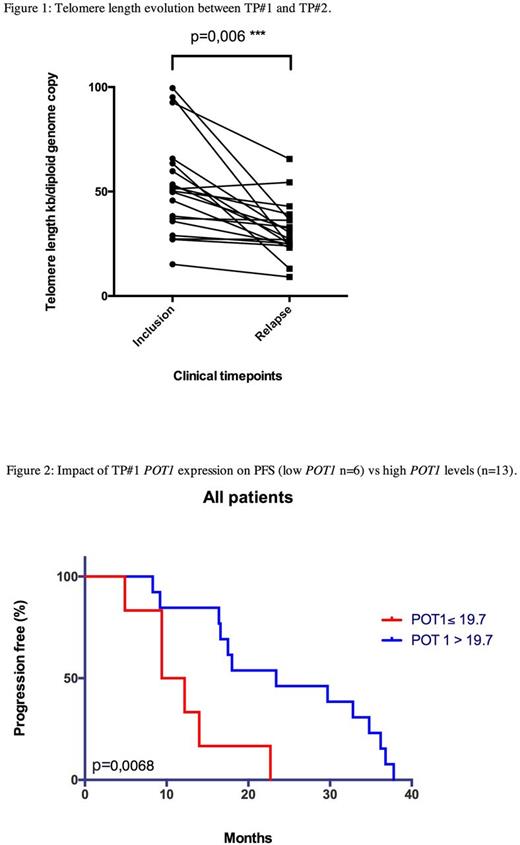Abstract
Background.
In patients (pts) with CLL, telomeric parameters have prognostic impact. In a retrospective study, we found that TP53 -disrupted pts show severe telomere dysfunction associated with high genomic instability and that downregulation of shelterin complex genes is an adverse prognostic factor in TP53 wild-type (wt) pts (Guièze, 2016). Recently, germline mutations in shelterin genes were found in familial CLL (Speedy, 2016) and a poor prognostic impact of somatic POT1 mutations (Ramsey, 2013) was reported in a front-line prospective study (Herling, 2016). A key and potentially early role of telomere dysfunction in disease progression is clearly suggested. The aim of this study was to assess telomeric parameters and their evolution in R/R CLL patients treated in a prospective trial.
Methods:
From a cohort of 74 R/R CLL pts included in the FILO phase II BOMP trial (NCT0161298) we identified 19 pts with available samples, with ≥70% tumor cell purity, at 2 successive time points (TP) to study the evolution of telomeric parameters. TP#1 was inclusion and TP#2 the subsequent CLL relapse after treatment (Bendamustine, Ofatumumab and high-dose Methyl-Prednisolone). The median time interval between the two TP was 17.5 months (mo) (range 4.9 - 37.8). The median follow-up was 33.9 mo (range 15.7 - 48.5). Prior to inclusion, 19 pts received 1 to 3 lines of treatment including FCR combination for all pts. Six patients had 17p deletion by FISH and TP53 mutation by Sanger and 13 pts had wt TP53 . Telomere length (TL) was assessed by qPCR and expression of telomerase( hTERT) and shelterin complex (TRF1, TRF2, TIN2, POT1, RAP1, TPP1) genes by qRT-PCR at TP#1 and TP#2. Survival analysis focused on the impact of telomeric parameters TP#1 on PFS.
Results:
Between TP#1 and TP#2, TL decreased significantly (p=0.0006) (Figure 1) and the expression of all shelteringenes also displayed a strong and significant diminution: TRF1 (2 fold-change, p<0.0001), TRF2 (2.7 fold-change, p<0.0001), POT1 (1.8 fold-change, p=0.0002), RAP1 (2 fold-change, p=0.0009), TPP1 (1.8 fold-change, p=0.0003), TIN2 (2.3 fold-change, p=0.0004). In contrast, no significant change in hTERT expression was found (p=0.64).
All patients did not present the same telomere shortening kinetics (TSK) between the two TP. We calculated TSK by mo and we identified 3 groups of patients: group #1 (n=4) with slow TSK (<0.3 kb/diploid genome/mo), group #2 (n=10) with intermediate TSK and group #3 (n=4) with fast TSK (>1.64 kb/diploid genome/mo). One patient extended TL. At TP#1, group #1 presented significantly slower TSK (p=0.005) and shorter TL (32.4 vs 75.9 kb/diploid genome, p=0.017) than group #3, with no significant difference in PFS.
At TP#1, the median TL was 50.2 kb/diploid genome (range 15.20 - 99.54). Patients with short telomeres (≤ median TL) had significantly shorter PFS (median of 12 vs 29.7 mo, p=0.009). For shelterin gene expression, the optimum cut-offs for PFS prediction were determined (POT1 : 19.7, TPP1 : 29.2, TIN2 : 18.5), corresponding to the 33rd percentile in expression levels. Significantly shorter survival times were found in patients with low expression of POT1 ≤ 19.7 (10.8 vs 23.4 mo, p=0.007), TPP1 ≤ 29.2 (11.7 vs 23.4 mo, p=0.03) and TIN2 ≤ 18.5 (10.8 vs 23.4 mo, p=0.0008).
When adjusted to TP53 status, TL kept a borderline impact on PFS (hazard ratio 2.86, CI95%: 0.98 to 8.0, p=0.055) while POT1 expression remained an independent prognostic factor (hazard ratio 4.35, CI 95%: 1.2 to 14.3; p=0.026) (Figure 2). TRF1, TRF2 or RAP1 levels had no significant effect on PFS.
In TP53 -wt population, short TL tended to be associated with shorter PFS (17 vs 32 mo, p=0.071). Significantly shorter PFS was found in patients with low POT1 (14 vs 31.25 mo, p=0.026) and TIN2 levels (9.4 vs 31.25 mo, p<0.0001).
Conclusion:
Interestingly, we found that following immunochemotherapy, telomere length and shelterin complex genes expression present a strong and different dynamic evolution over time that may preclude a next step of genomic instability. In this cohort of CLL pts with post-FCR relapse, telomeric parameters before treatment confirmed their prognostic impact on PFS. This analysis done 19 patients have to be extended to the entire BOMP trial cohort (n=74) and confronted to other biological parameters including cytogenetics, pantelomeric FISH and targeted-NGS mutational pattern.
Feugier: Roche: Consultancy, Honoraria, Research Funding. Dilhuydy: Janssen: Consultancy, Honoraria, Other: Travel, Accommodations, Expenses; Gilead: Consultancy, Honoraria; Roche: Consultancy, Honoraria. Ysebaert: Janssen: Consultancy, Research Funding, Speakers Bureau. Delmer: Janssen: Honoraria; Roche: Consultancy, Honoraria; Gilead: Consultancy, Honoraria; Abbvie: Consultancy, Honoraria. Guieze: ABBVIE: Other: Educational Presentation; JANSSEN: Other: Educational Presentation; GILEAD: Other: Educational Presentation. Schuh: Novartis: Honoraria; Celgene: Honoraria; Gilead: Honoraria, Research Funding; Roche: Honoraria; Janssen: Honoraria; Abbvie: Honoraria; Gilead: Consultancy; Roche: Honoraria; Janssen: Honoraria; Celgene: Honoraria; Abbvie: Honoraria; Novartis: Honoraria. Leblond: Roche: Honoraria, Membership on an entity's Board of Directors or advisory committees, Speakers Bureau; Servier: Honoraria, Membership on an entity's Board of Directors or advisory committees; Novartis: Honoraria, Membership on an entity's Board of Directors or advisory committees; BMS: Honoraria; Janssen: Honoraria, Membership on an entity's Board of Directors or advisory committees, Speakers Bureau; Abbvie: Honoraria, Membership on an entity's Board of Directors or advisory committees, Speakers Bureau; Gilead: Honoraria, Membership on an entity's Board of Directors or advisory committees. Tournilhac: AMGEN: Other: Travel funding, Research Funding; Janssen: Honoraria, Other: travel funding; ROCHE: Honoraria, Other: Travel funding, Research Funding; GILEAD: Honoraria, Other: Travel Funding, Research Funding; Abbvie: Honoraria, Other: Travel funding.
Author notes
Asterisk with author names denotes non-ASH members.


This feature is available to Subscribers Only
Sign In or Create an Account Close Modal